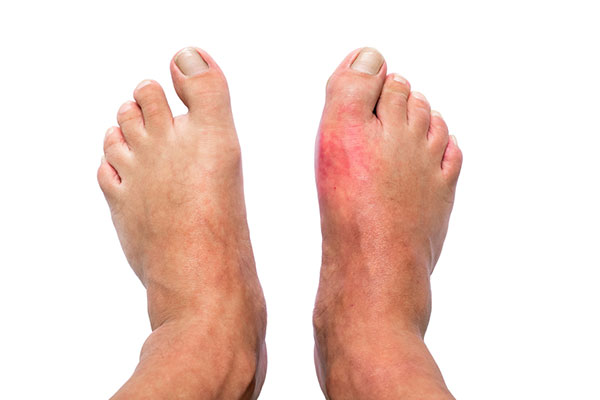
Gout is one of those health conditions that can strike just about anyone. Gout commonly manifests as pain similar to what suffers with rheumatoid arthritis (RA) will experience. Both gout and RA cause inflammation of the joints, with gout usually affecting the joins of the big toe.
While gout has had a long history of being associated with rich older men, in actual fact, gout can affect anyone of any age or sex. The condition is caused by a buildup of uric acid in the blood that accumulates as sharp crystals in the joints of your big toes.
People will notice swelling of the big toe, warmth in the joint and a reddening of the skin. The joint can feel so painful that even touching the affected area with your fingertip can cause severe pain. This means having gout can interfere with your everyday life and the things we usually take for granted, like walking or wearing socks and shoes.
Sometimes an attack of gout can feel so painful that even the weight of a bedsheet on your toe while sleeping can cause you to wake up in pain.
What causes gout?
There can be a number of contributing factors to someone developing gout. It can be caused by genetics, so you may be more predisposed to getting the condition yourself if gout runs in your family.
Gout can also be triggered by health and lifestyle factors, such as a poor diet and living a sedentary life. Regular gentle exercise like walking or swimming is encouraged because it helps your circulatory system move essential nutrients around your body and flush out the purines that cause uring acid crystals that can build up in your joints and cause gout.
Unfortunately, there is no cure for gout, but there are a lot of things you can do to help get relief from a gout attack, reduce the inflammation that causes it, and lower your risks of suffering further attacks in the future.
How to get fast relief from gout attacks
You can do a few things for yourself at home to help bring quick relief from a gout attack. However, if you have noticed that you are getting more frequent and severe gout flare-ups, it would be wise to consult with your doctor or a specialist rheumatologist for some professional help and support.
Your doctor or specialist can work with you to devise the correct medical treatment and lifestyle plan to help you manage your condition. With the proper medical support, you will be able to remain in control of your condition and prevent it from interfering as much with your everyday life.
However, you can use some over-the-counter pain relievers at home to help bring the pain and inflammation down. Keep some nonsteroidal anti-inflammatory drugs (NSAIDs) like ibuprofen at home for some immediate relief from the pain of a gout attack.
You can also keep some topical muscle rubs in your medical cabinet. Many muscle rubs contain warming and pain-relieving ingredients that can help with both pain and inflammation when applied to a swollen toe.
Take care when applying any topical creams or muscle rubs to the affected area. Suppose the skin around the joint is broken or has developed any sores. In that case, you may irritate the skin more by applying a topical treatment, especially if it contains capsicum that can cause more irritation.
Keep an ice pack in your freezer, so you will always have it ready to help calm down a gout attack. Applying ice to the affected joint is one of the fastest and easiest ways to reduce the heat and swelling associated with a gout flare.
Treatment for chronic gout
Making sure you stay well hydrated will help with your gout condition. Drinking plenty of water will help the body flush out the buildup of urate, which creates uric acid crystals that build up in your joint and causes inflammation and pain.
Recent studies have shown that drinking adequate water during the 24 hours before a gout flare can decrease the intensity and recurrent gout attacks. Although it is recommended to drink freshwater rather than rely on fizzy drinks, tea, coffee and fruit juice to get enough hydration in.
Prescription treatments from your doctor or gout specialist can be used when your pain becomes unbearable. In severe attacks over the counter medication such as ibuprofen may not be enough to bring down the pain and swelling.
What is the best thing for gout in the big toe?
Your doctor can prescribe you stronger medication to use to quell an attack, so make sure you are getting professional help to manage your condition. You may even benefit from a corticosteroid treatment, such as a steroid joint injection that your gout specialist can control.
You will more than likely need to have a long-term treatment plan put in place for you by your doctor to help manage and prevent further gout attacks. This can include prescription medication to lower the uric acid levels in your body.
Working with a specialist rheumatologist such as Dr Bhadaria and his team is helpful here as your plan can be personally tailored for you.
Warning signs of a gout flare-up
If you have already experienced a gout attack, you may notice some warning signs of an upcoming attack easier than someone who has never experienced gout before.
Some things to look out for before you start to feel any pain in the joint include a warm feeling in your big toe, a reddening of the skin on your toe that starts to spread around the joint, and a lingering tingling feeling in your toe.
Some things can trigger a gout attack that you should be aware of. These can include a knock or injury to the joint that can shake loose the crystals in your joint cavity, which can trigger an attack.
Even taking part in some sports or exercise, like tennis or other court sport, can cause enough impact on your joints to cause uric acid crystals to move in your joints and cause a flare. Make sure you drink plenty of water to rehydrate yourself properly after your workout or a busy day on your feet to reduce the risks of triggering a flare.
What are the best things to eat and drink if you have gout?
We now know that overconsuming foods and drinks high in fructose and alcohol are leading contributors to uric acid buildup in the body. Your kidneys may struggle to process high levels of the purines and other toxins found in many common food and drinks, and our modern Western diet is full of food and drinks that are not good for our health.
Purines are chemicals found in food and drink that your body metabolises into uric acid, which can cause gout flares. Consuming a diet that is high in sugar and alcohol is the worst thing you can do if you want to avoid having gout attacks.
The old myth that gout was a disease of the rich is somewhat based on truth. Hundreds of years ago, gout only tended to affect those who could afford to eat a rich diet of alcohol and sugar-laden foods every day.
However, modern food manufacturing and processing techniques have now made it easy for everyone to eat an ultra-processed diet full of flour, sugar and industrial vegetable oils. These are the three things that now make up most food in our diet.
High fructose corn syrup, for example, is a cheap ingredient that food manufacturers put in most snacks and sugary drinks. Fructose absolutely should be avoided if you want to prevent triggering a gout attack.
If you are unsure of what you should be eating, discuss your meal plan options with your doctor or gout specialist.
Does walking on a gout foot make it worse?
It can help to stay off your feet when experiencing a gout flare-up until it subsides. Resting your feet can also help to prevent any further micro-trauma to the joint that can worsen the inflammation and pain felt.
Once the pain and swelling have subsided enough to move around again, you can resume low-impact activities again, such as walking, swimming, yoga, etc. Regular low-impact physical exercise is encouraged to help your circulation flush out uric acid from your blood and prevent a further gout attack.
Long-term management and lifestyle changes
If you are experiencing gout attacks more frequently or your gout flares are becoming more intense, it makes sense to work with a professional gout specialist to develop an effective long-term management plan.
Dr Bhadauria and his team focus on providing their patients with a holistic approach. This can include a combination of quick and effective medication to help relieve the pain of a gout flare-up, plus a personally tailored diet and lifestyle programme that incorporates healthy eating and regular exercise to reduce the risk and severity of future gout flares.
Do not hesitate to contact our team for more help and to book a private consultation to help you manage your gout condition.
Article by Dr. Naveen Bhadauria



